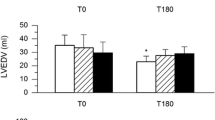Summary
Endotoxin has been shown to deteriorate autoregulation of Wood flow in liver, kidney and splanchnic organs. Despite frequently observed early changes in mental status in septic patients, regional cerebral blood flow (rCBF) has not been studied during the initial phase of endotoxemia. In 10 barnraised pigs, hyperdynamic endotoxemia was induced by continuous i.v. infusion of S. abortus equi endotoxin (total dose 13 μg/kg). A fall in pulmonary capillary wedge pressure (PCWP) was prevented by controlled infusion of Dextran 60. Arterial PCO2 was maintained at 40 mmHg by adapting the tidal volume of the respirator. Central hemodynamics, ventilatory parameters and rCBF (quantified by means of radioactively labeled microspheres ø15 μm) were measured before and 30, 90 and 150 min after endotoxemia. Furthermore, the concentration of endotoxin in the plasma was quantified using chromogenic substrate (Limulus A moebocyte Lysate Test). Despite a significant drop in mean aortic pressure from 128 to 78 mmHg within 90 min of endotoxemia, the blood flow in cerebral cortex, medulla, nucleus caudatus, brain stem lamina quadrigemina and cerebellum remained within the control range. rCBF was independent of the actual concentration of endotoxin in the plasma. In contrast, deterioration of microcirculatory perfusion was observed in myocardium and kidney. We are led to conclude that the autoregulation of rCBF is maintained during the initial phase of endotoxemia. The results of the present study suggest that brain vessels respond differently to endotoxin or endotoxin-released mediators from visceral vessels.
Similar content being viewed by others
References
Schosser R, et al. Mic-I-A program for the determination of cardiac output, arterio-venous shunt and regional blood flow using the radioactive microsphere method. Comput Prog Biomed 1979; 9: 19–38.
Hall RC, Hodge RL. Vasoactive hormones in endotoxin shock: a comparative study in cats and dogs. J Physiol 1971; 203: 69–84.
Ekström-Jodal B, et al. Effects of noradrenaline on the cerebral blood flow in the dog. Acta Neurol Scand 1974; 50: 11–26.
MacKenzie ET, et al. Cerebral circulation and norepinephrine: relevance of the blood-brain barrier. Amer J Physiol 1976; 231: 483–8.
Anderson FI, et al. Endotoxin-induced prostaglandin E and F release in dogs. Amer J Physiol 1975; 228: 410–4.
Pickard JD, et al. Prostaglandin-induced effects in the primary cerebral circulation. Eur J Pharmacol 1977;43: 343–51.
Pener A, Bernheim AE. Studies in the pathogenesis of experimental dysentery intoxication: production of lesions by introduction of toxin into the cerebral ventricles. J Exp Med 1960:111: 145–53.
EkstrΩ-Jodal B, et al. Cerebral blood flow and oxygen uptake in endotoxic shock. An experimental study in dogs. Acta Anaesth Scand 1982; 26: 163–70.
Kogure K, et al. Mechanisms of cerebral vasodilation in hypoxia. J Appl Physiol 1970; 29: 223–9.
Parker JT, Emerson TE. Cerebral hemodynamics, vascular reactivity, and metabolism during canine endotoxin shock. Circ Shock 1977; 4: 41–53.
Brian WJ, Emerson TE. Blood flow in seven regions of the brain during endotoxin shock in the dog. Proc Soc Exp Biol Med 1977; 156: 205–8.
Somani P. A comparison of the cardiovascular, renal, and coronary effects of dopamine and monensin in endotoxic shock. Cir Shock 1981; 8: 451–64.
Lambalgen A, et al. Distribution of cardiac output, oxygen. consumption and lactate production in canine endotoxin shock. Cardiovasc Res 1984; 18: 195–205.
Messmer K. Septic shock: Pathophysiology and clinical features. Intensivmed Notfallmed Anästhesiol 1985; 52: 2–3.
Author information
Authors and Affiliations
Rights and permissions
About this article
Cite this article
Zhen, Y., Kreimeier, U. & Messmer, K. Regional changes in cerebral blood flow during acute endotoxemia. Journal of Tongji Medical University 7, 131–135 (1987). https://doi.org/10.1007/BF02888205
Issue Date:
DOI: https://doi.org/10.1007/BF02888205




